| Index |
| S.No | Topic | Page No |
| Daily Hindu Analysis (YouTube) |
| 1. | The Tailwinds from Lower Global Oil Prices |
|
| 2. | Immigration and the Politics of Fear |
|
| 3. | Ladakh Delegates Offered Terms of Article 371 by Govt. |
|
| 4. | Union Govt. Proposes Mandatory Labelling of Synthetic AI-Generated Content on Social Media |
|
| 5. | Officers Issuing Content Notice to be Made More ‘Accountable’ |
|
| 6. | When a Parasitic Wasp Saved South’s Tapioca Crops |
|
| 7. | Great Green Wall in A.P. to Save Coastline from Degradation |
|
| Daily Current Affairs |
| 8. | Skilling for AI Readiness (SOAR) Programme |
|
| 9. | Indian Scops-Owl |
|
| 10. | Central Asian Mammals Initiative |
|
| 11. | Trachoma |
|
The Tailwinds from Lower Global Oil Prices
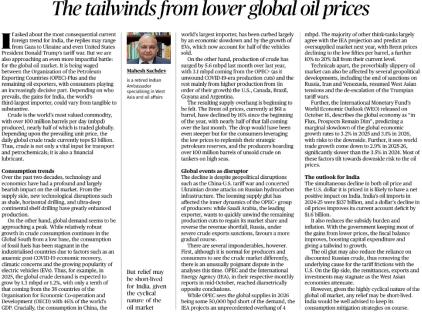
GS Paper: 3 – Indian Economy, Energy Security, External Sector, International Economic Issues
Context: The global oil market is witnessing a significant downward trend in prices due to a surge in supply and slower demand growth. For India — the world’s third-largest oil importer — this development has the potential to create major macroeconomic and fiscal benefits, while also reflecting deeper shifts in global energy and geopolitical dynamics. The Brent crude oil price, currently around $61 per barrel, has declined by nearly 16% since the beginning of 2025, largely due to increased output from OPEC+ and non-OPEC countries and weak demand growth in advanced economies. However, experts caution that these “tailwinds” for India may be short-lived, given the cyclical and politically sensitive nature of the global oil market.
Background: Oil is the world’s most traded commodity, with over 100 million barrels produced daily — nearly half of which is traded internationally.
It plays a dual role:
- A vital energy source for transport and industry.
- A financial lubricant affecting inflation, currency value, and global trade balances.
The current decline follows a long phase of price volatility driven by multiple factors — COVID-19 disruptions, OPEC+ output cuts, Russia–Ukraine conflict, and fluctuating global demand.
Factors Behind the Recent Fall in Oil Prices:
A. Supply Surge:
- Oil production increased by 5.6 million barrels per day over the last year, with:
- OPEC+ adding 3.1 mbpd (as COVID-era cuts unwind).
- Non-OPEC countries like the U.S., Canada, Brazil, Guyana, and Argentina ramping up production.
- Stockpiling of unsold crude (over 100 million barrels) on tankers further added to market oversupply.
B. Demand Weakness: - Global economic slowdown, especially in OECD economies, has lowered fuel consumption.
- Electric vehicle (EV) adoption and improved fuel efficiency are structurally dampening long-term demand.
- China’s slowdown and post-COVID recovery fatigue have reduced import momentum.
C. Technological and Structural Factors:
- Advances in shale extraction and ultra-deep drilling have enhanced supply resilience.
- Energy transition policies in advanced economies are steering consumption away from hydrocarbons.
D. Geopolitical Context: - Despite regional tensions (Ukraine war, West Asia instability), oil prices remain subdued due to supply surpluses.
- The OPEC–Russia dynamics are also shifting — with Saudi Arabia seeking to regain market share while Russia, under sanctions, opts for gradual production increases.
Global Economic Implications: Short-Term: - Lower oil prices are expected to reduce global inflation and support fragile post-pandemic recovery.
- According to the IMF World Economic Outlook (2024), global GDP growth is projected at 3.2% in 2025 and 3.1% in 2026, but the overall momentum remains fragile.
Long-Term: - Persistent low prices may discourage investment in new oil exploration, leading to future supply constraints.
- They may also delay the green energy transition as fossil fuels become cheaper relative to renewables.
The Outlook for India: A. Economic Gains:
1. Reduced Import Bill: India imports over 85% of its crude oil needs. o A decline in prices by $10 per barrel saves India around $16 billion annually. o For FY 2024–25, oil imports are expected to cost $137 billion, with savings improving the current account deficit (CAD) by $1.6 billion.
2. Lower Inflation and Fiscal Deficit: o Cheaper oil reduces input costs, moderates WPI and CPI inflation, and eases the subsidy burden. o The government gains fiscal space for social and capital expenditure.
3. Stronger Rupee and External Stability: o A lower oil import bill improves the trade balance, stabilising the rupee against the dollar.
4. Investment and Growth Boost: o Reduced energy costs increase corporate profitability and spur industrial growth. o Sectors such as aviation, logistics, manufacturing, and fertilizers benefit directly.
B. Strategic Benefits:
- Enables diversification of energy imports and reduces dependence on discounted Russian oil.
- Offers a window for India to replenish its strategic petroleum reserves (SPR) at lower costs.
C. Social Impact: - Reduced fuel prices alleviate cost pressures on households and small businesses.
However, Relief May Be Short-Lived: The global oil market is highly cyclical and politically influenced. - Geopolitical risks (renewed conflict in the Middle East, Russia sanctions tightening) could quickly reverse the trend.
- OPEC+ production cuts or coordinated output restrictions could push prices back above $80/barrel.
- Long-term underinvestment in oil exploration may trigger price spikes in future.
- For India, benefits may fade if the rupee weakens or if taxes on fuel are adjusted upward.
UPSC Mains: Q.
“Falling global crude oil prices provide short-term relief for India but pose long-term policy challenges.” Discuss in the context of India’s energy security and macroeconomic stability.
Immigration and the Politics of Fear
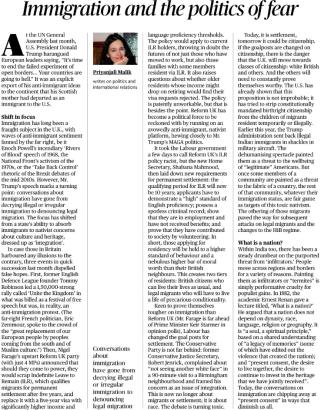
GS Paper: 2 – Governance, International Relations, Political Ideologies, Ethics in Politics Context:
The editorial analyses the growing anti-immigrant sentiment in Western democracies — particularly the United Kingdom (UK) — and how populist politics is weaponizing immigration to shape narratives of fear, division, and exclusion. · The discussion draws on recent remarks by former U.S. President Donald Trump at the UN, who attacked the idea of “open borders” while influencing European far-right rhetoric. It argues that anti-immigrant populism, often masked as “integration” or “security,” has turned immigration from a socio-economic issue into an ideological tool. · This trend reflects a global pattern of nativist politics, where national identity and belonging are defined through exclusion, echoing similar developments in India, Europe, and the United States. Background:
- Immigration has historically been a divisive and emotive issue in Western politics.
- In the UK, debates around immigration date back to Enoch Powell’s 1968 “Rivers of Blood” speech, the National Front movements of the 1970s, and the Brexit rhetoric of “Take Back Control.”
- However, the current wave of anti-immigration politics goes beyond illegal migration — it now targets legal migrants, asylum seekers, and even settled residents, reflecting a deepening politics of fear.
The Current Shift: From Irregular to “Legal” Migration The article highlights that recent UK policies and rhetoric (by parties like Reform UK and Conservative leaders) are no longer limited to controlling illegal migration. Instead, they:
- Target legal migrants with permanent or indefinite residency.
- Introduce stringent conditions for settlement, such as longer qualification periods and “high standards” of English proficiency.
- Impose moral and economic tests to assess “worthiness” of residency or citizenship.
- Frame immigrants as a threat to welfare systems, public safety, and national culture.
The Politics of Fear and Populism: - Anti-immigration politics is performative populism — appealing to majoritarian insecurities under the guise of nationalism.
- By projecting migrants as “others” or “outsiders”, populist leaders mobilize public anger to divert attention from economic and governance failures.
- Such politics simplifies complex socio-economic problems (like unemployment or housing shortages) into identity-based conflicts.
- The dehumanisation of migrants (as seen in Trump’s policy of shackling Indian and Latin American immigrants) fosters a toxic atmosphere of cultural superiority.
The Idea of “Nation” – Historical and Philosophical
Context: The article invokes the 19th-century French philosopher Ernest Renan’s 1882 lecture “What is a Nation?”, where he argued: “A nation is not based on race, religion, or geography, but on shared memories, collective consent, and the desire to live together.” Thus, defining a nation by exclusion — as the far-right does — contradicts the civic, moral, and pluralist foundations of modern democracies. Implications:
A. Political Implications:
- Weakens democratic pluralism and normalizes majoritarian nationalism.
- Leads to policy capture by extremist or identity-driven politics.
- Undermines global norms on human rights and refugee protection.
B. Social Implications: - Creates hierarchies of citizenship — “deserving” vs. “undeserving” populations.
- Fuels xenophobia, discrimination, and violence against minorities and migrants.
- Erodes the moral legitimacy of multiculturalism and civic equality.
C. Global Implications: - The rise of transnational populism (U.S.–Europe linkages) shows that political fear campaigns can cross borders as rapidly as migration itself.
- Such rhetoric also weakens collective international responses to refugee crises, climate migration, and global inequality.
UPSC Mains: Q.
“Contemporary politics has transformed immigration from a socio-economic issue into a cultural tool of fear and exclusion.” Discuss with reference to global trends in populism and nationalism.
Ladakh Delegates Offered Terms of Article 371 by Govt.

GS Paper: 2 – Governance, Polity, Federalism, Centre–State Relations, Special Provisions for States and UTs
Context: Civil society groups in Ladakh, led by the Leh Apex Body (LAB) and Kargil Democratic Alliance (KDA), recently resumed talks with the Ministry of Home Affairs (MHA) over constitutional safeguards for the Union Territory. The MHA proposed special provisions under Article 371 of the Constitution for Ladakh — but the groups insist on inclusion under the Sixth Schedule and restoration of statehood. This dialogue follows months of protests, including hunger strikes and violent clashes in Leh, after four protestors (including a Kargil war veteran) were killed during police action.
Background:
- After the abrogation of Article 370 in August 2019, Ladakh was carved out of the erstwhile State of Jammu & Kashmir and made a Union Territory without a Legislative Assembly.
- Since then, Ladakhis have demanded:
- Full statehood,
- Protection of land, culture, and jobs, and
- Autonomous self-governance under the Sixth Schedule (as applicable to tribal areas).
- The Ladakh Apex Body (LAB) and Kargil Democratic Alliance (KDA) have spearheaded the movement representing both Buddhist and Muslim-majority regions.
What Is Article 371? | Aspect | Details |
| Location in Constitution | Part XXI – Temporary, Transitional, and Special Provisions |
| Purpose | To grant special provisions to certain states for protecting local customs, laws, and administrative arrangements. |
| Currently Applicable to | 12 States – Nagaland, Assam, Manipur, Mizoram, Meghalaya, Arunachal Pradesh, Sikkim, Himachal Pradesh, Maharashtra, Gujarat, Goa, and Karnataka. |
| Nature of Provisions | Vary across states — deal with tribal land protection, local employment, customary law, and administrative autonomy. |
Article 371-type safeguards offer limited autonomy and cultural protection, unlike the Sixth Schedule, which provides institutional self-rule through Autonomous District Councils (ADCs).
Significance of the Issue: 1. Protection of Tribal Culture: o Over 97% of Ladakh’s population is Scheduled Tribe, making Sixth Schedule inclusion constitutionally and demographically justified.
2. Federal Balance: o Provides a framework for reconciling Centre’s strategic control (border security) with local autonomy and governance participation.
3. Model for Other UTs: o Could set a precedent for adaptive governance models in Union Territories with unique ethnic or ecological sensitivities.
4. Political and Strategic Sensitivity: o Ladakh borders China and Pakistan; stability here has both domestic and strategic importance for India’s sovereignty.
Challenges:
| Challenge | Explanation |
| 1. Centre–Region Trust Deficit | Protesters allege slow response and lack of clarity from the MHA. |
| 2. Constitutional Complexity | Sixth Schedule applies only to Assam, Meghalaya, Mizoram, Tripura — extending it to Ladakh requires constitutional amendment. |
| 3. Administrative Feasibility | Balancing tribal autonomy with Ladakh’s strategic governance (Army, BRO, ITBP control). |
| 4. Political Division | Differences between Leh (Buddhist-majority) and Kargil (Muslim-majority) over approach and priorities. |
UPSC Prelims Q. Consider the following statements regarding special constitutional provisions for certain states and regions in India: 1. Article 371 provides for temporary and transitional provisions aimed at protecting the cultural and administrative practices of certain states. 2. The Sixth Schedule of the Constitution deals with the administration of tribal areas in selected northeastern states. 3. Ladakh is already included under the Sixth Schedule of the Constitution. 4. Extending the Sixth Schedule to a new region requires a constitutional amendment under Article 368. Which of the statements given above is/are correct?
(a) 1 and 2 only
(b) 1, 2 and 4 only
(c) 2 and 3 only
(d) 1, 3 and 4 only
Answer: (b) 1, 2 and 4 only
Union Govt. Proposes Mandatory Labelling of Synthetic AI-Generated Content on Social
Media GS Paper: 3 – Science & Technology, Cybersecurity, IT Governance, Ethics in Artificial Intelligence
Context: The Ministry of Electronics and Information Technology (MeitY) has proposed a major amendment to the Information Technology (Intermediary Guidelines and Digital Media Ethics Code) Rules, 2021, making it mandatory for social media platforms to label and disclose AI-generated synthetic content. This move aims to tackle deepfakes, misinformation, impersonation, and digital manipulation, ensuring users know when content has been created or altered using artificial intelligence. The amendment requires all forms of AI-generated material — videos, photos, audio, or text — to carry clear disclosure labels, thus marking a shift from reactive penalty-based regulation to preventive transparency in AI content governance.
Background:
- Deepfakes — AI-generated or altered videos and images — have emerged as a global threat, spreading misinformation and violating individual privacy.
- Instances in India have included morphed videos of celebrities, political impersonations, and doctored speeches, prompting calls for stronger regulation.
- MeitY’s proposal aligns India’s approach with international developments such as the EU’s AI Act and the U.S. Deepfake Disclosure Acts, emphasizing the principle of “responsible AI.”
Key Provisions of the Draft Amendment: Mandatory Disclosure All synthetic or AI-generated content — including text, images, videos, and audio — must carry a visible or audible label indicating it is AI-generated.
The disclosure must cover at least 10% of the surface area in audiovisual posts, ensuring it is clearly visible to users.
Platform Accountability Social media intermediaries must:
- Allow users to self-declare if their uploaded content is AI-generated.
- Proactively detect and label such content if users fail to disclose it.
Permanent Metadata or Identifier The AI-generated post must include a permanent metadata tag or identifier, embedded or displayed prominently, ensuring authenticity tracking even after sharing or reposting.
Broad Applicability The rule applies to all kinds of synthetic content — not just photorealistic visuals — but also AI-modified text, speech, or music, ensuring a comprehensive approach. Enforcement & Feedback The draft amendment has been opened for public consultation till November 6, 2025, after which it will be formally notified. Significance: 1. Curbing Deepfakes and Misinformation:
The measure ensures manipulated AI content is traceable and publicly identifiable, reducing risks of misinformation, impersonation, and fake news.
2. Promoting Digital Trust:
It helps social media users make informed decisions by clearly distinguishing between authentic and synthetic media, building credibility in online spaces.
3. Strengthening AI Ethics:
The proposal promotes ethical and transparent AI practices in line with global principles, supporting India’s emerging leadership in responsible AI governance.
4. Pre-emptive Policy Shift:
Instead of reacting to misuse, the rule introduces a preventive regulatory mechanism — ensuring compliance before harm occurs.
5. Protection of Privacy and Individual Dignity:
The rule safeguards individuals, especially women and public figures, from non-consensual AI-generated content and digital harassment.
Challenges: · Despite its importance, several challenges remain.
First, detection at scale remains technically difficult, as identifying AI-generated content requires advanced machine-learning tools that smaller platforms may not possess. · Second, definitional ambiguity persists — differentiating between “AI-edited,” “AI-assisted,” and “AI-generated” content can be complex. · Third, there is a risk of over-regulation, where creative expression, satire, or digital art could be unfairly labelled, stifling innovation. · Fourth, implementation and monitoring will require continuous coordination between government, platforms, and AI developers. · Finally, absence of a dedicated AI legislation or oversight body in India may delay uniform enforcement and accountability mechanisms.
UPSC Prelims Q. With reference to the draft amendment to the IT Rules, 2021, recently proposed by MeitY, consider the following statements:
1. All AI-generated synthetic content must carry a clear and visible disclosure or label.
2. The disclosure must cover at least 10% of the surface area of the audiovisual post.
3. The amendment applies only to AI-generated videos, not to text or audio content.
4. Platforms must proactively label AI-generated content if users fail to self-declare. Which of the statements given above is/are correct?
(a) 1, 2 and 4 only
(b) 1 and 3 only
(c) 2 and 3 only
(d) 1, 2, 3 and 4
Answer: (a) 1, 2 and 4 only
Officers Issuing Content Notice to be Made More ‘Accountable’
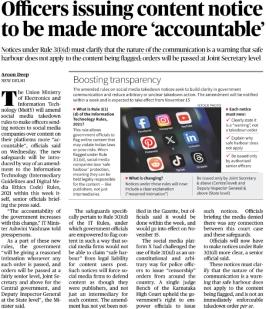
Syllabus Mapping: GS Paper: 2 – Governance, Constitution, Transparency & Accountability, Role of Government in Communication and Technology Regulation
Context: The Ministry of Electronics and Information Technology (MeitY) is set to amend the Information Technology (Intermediary Guidelines and Digital Media Ethics Code) Rules, 2021, to make government officers issuing social media content takedown notices more accountable and transparent. The amendment will come into effect from November 15, 2025, aiming to curb arbitrary or unclear takedown actions by introducing higher-level authorisation and clearer communication requirements. This move comes in the backdrop of criticism from digital platforms (especially Platform X / Twitter) that the government’s use of Rule 3(1)(d) was opaque and excessive, allegedly leading to censorship concerns.
Background:
- Rule 3(1)(d) of the IT Rules, 2021, empowers government officials to flag online content that may violate Indian laws or pose national/security risks.
- Once flagged, social media intermediaries (Facebook, X, Instagram, YouTube, etc.) may lose their “safe harbour” protection under Section 79 of the IT Act, meaning they can be held legally responsible for the content they host.
- The proposed amendment seeks to add procedural transparency and accountability in the way such notices are issued.
Key Provisions of the Amendment: A. Clear Classification of Notices
- Every notice must explicitly state that it is a “warning” and not a direct “takedown order.”
- The notice must clarify why “safe harbour” protection does not apply to the flagged content.
B. Senior-Level Authorisation - Only Joint Secretary (Central Government) or above and Deputy Inspector General (State Government) or above can issue notices under Rule 3(1)(d).
C. “Reasoned Intimation” - Notices must include a clear, written explanation of the reason for flagging, ensuring that the action is well-founded, not arbitrary.
D. Enhanced Transparency - The amendment aims to reduce misuse of the takedown power, improve communication clarity between the government and platforms, and protect users’ right to free expression within legal limits.
Significance of the Move: 1. Promotes Accountability:
– Moves decision-making to higher administrative levels, reducing arbitrary or politically motivated orders.
2. Strengthens Transparency:
– Mandates reasoned orders with clear communication, aligning with principles of natural justice and due process.
3. Balances Governance and Freedom:
– Protects users’ right to expression while ensuring legitimate oversight to curb misinformation, hate speech, and unlawful content.
4. Restores Trust in Digital Regulation:
– Addresses industry concerns of censorship and builds confidence among intermediaries and civil society.
5. Aligns with Democratic Values:
– Reflects India’s commitment to open governance and responsible digital regulation in line with Article 19(2) of the Constitution.
Challenges Ahead:
- Ambiguity on “Safe Harbour”:
Determining when an intermediary loses safe harbour could still invite legal disputes. - Risk of Overreach:
Despite senior-level oversight, lack of judicial review may still allow broad interpretations of “offensive” or “risky” content. - Implementation Gaps:
The capacity and digital literacy of officers issuing notices need to be strengthened to ensure proper reasoning and documentation. - Balancing Free Speech & Security:
Maintaining the equilibrium between freedom of expression and prevention of unlawful content remains a continuing challenge.
Way Forward: - Introduce independent review mechanisms for takedown requests.
- Mandate periodic public disclosure of takedown notices to enhance transparency.
- Train authorised officers on constitutional safeguards and content moderation ethics.
- Strengthen digital grievance redressal mechanisms under the IT Rules.
UPSC Prelims: Q. Consider the following statements regarding the Information Technology (Intermediary Guidelines and Digital Media Ethics Code) Rules, 2021: 1. Rule 3(1)(d) empowers government officials to flag online content that may violate Indian laws or pose risks.
2. Once content is flagged, social media intermediaries continue to enjoy “safe harbour” protection under Section 79 of the IT Act.
3. Under the new amendment, only officers at the Joint Secretary level and above can issue such notices. Which of the statements given above is/are correct?
(a) 1 and 2 only
(b) 1 and 3 only
(c) 2 and 3 only
(d) 1, 2 and 3
Answer: (b) 1 and 3 only
When a Parasitic Wasp Saved South’s Tapioca Crops
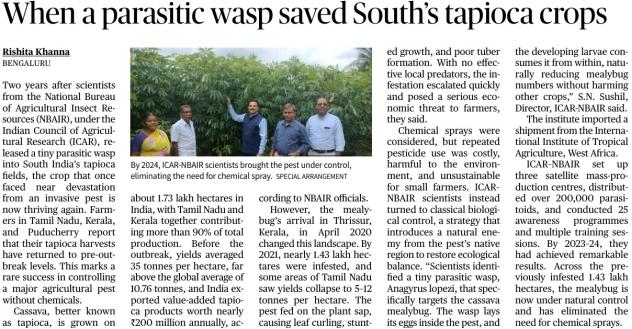
GS Paper: 3 – Science & Technology, Agriculture, Biodiversity & Environment
Context: · In a landmark success for sustainable agriculture, scientists from the National Bureau of Agricultural Insect Resources (NBAIR) under the Indian Council of Agricultural Research (ICAR) have successfully controlled the cassava mealybug pest using a tiny parasitic wasp (Anagyrus lopezi). · This biological intervention restored tapioca (cassava) cultivation in Tamil Nadu, Kerala, and Puducherry, where farmers had suffered near-total crop loss due to the pest since 2020. · By 2024, tapioca yields returned to pre-outbreak levels — achieved without chemical pesticides, marking one of India’s most successful biological control operations in recent years.
Background:
- Cassava (Manihot esculenta) is a key tuber crop grown across 1.73 lakh hectares in India, contributing to both food security and industry (starch production, sago, etc.).
- India is the world’s third-largest cassava producer, with Tamil Nadu and Kerala accounting for over 90% of production.
- In April 2020, the cassava mealybug (Phenacoccus manihoti) was reported in Thrissur, Kerala — spreading rapidly across the South, cutting yields by over 60–70%.
Chemical pesticides failed due to cost, environmental risks, and pest resistance — prompting scientists to adopt classical biological control methods.
Key Intervention: ICAR–NBAIR’s Biological Control Strategy
| Step | Measure Taken | Details |
| 1. Identification | Detected cassava mealybug (Phenacoccus manihoti)* as invasive pest. | Originated in Africa; first time seen in India. |
| 2. Biological Solution | Introduced parasitic wasp (Anagyrus lopezi). | The wasp lays eggs inside the mealybug; larvae consume pest from within — host-specific and eco-safe. |
| 3. Collaboration | Imported wasps from International Institute of Tropical Agriculture (IITA), West Africa. | Ensured no threat to local ecosystems. |
| 4. Implementation | ICAR–NBAIR set up 3 mass-production centres, distributed >2 lakh parasitoids, and held 25 awareness & training sessions for farmers. | |
| 5. Outcome (2023–24) | Pest population reduced drastically; tapioca yields restored to pre-outbreak levels. | Farmers no longer required pesticide use. |
Significance: 1. Sustainable Agriculture Model:
– Eliminated pest naturally, avoiding chemical pesticide pollution.
– Restored ecological balance and biodiversity in affected regions. 2. Cost-effective & Farmer-friendly:
– Reduced input costs for small farmers.
– Prevented economic losses across 1.43 lakh hectares. 3. Environmental Impact:
– Avoided pesticide-induced soil degradation, water contamination, and harm to pollinators. 4. Scientific & Policy Relevance:
– Demonstrates success of “Atmanirbhar Krishi” through indigenous scientific innovation.
– Aligns with India’s National Mission on Sustainable Agriculture (NMSA) and SDG 15 (Life on Land).
Challenges & Way Forward:
| Challenges | Way Forward |
| 1. Limited awareness among farmers about biological control. | Scale up farmer-training and Krishi Vigyan Kendra (KVK) outreach. |
| 2. Delays in pest identification and response. | Strengthen pest surveillance and rapid-response teams. |
| 3. Risk of ecological imbalance if non-native species are misused. | Ensure host-specific biological agents only under ICAR supervision. |
| 4. Dependence on external institutions for biocontrol species. | Develop national bio-agent repositories and indigenous R&D capacity. |
Broader Impact & Lessons: - Proves that eco-friendly pest management can be more effective than chemical control.
- Reinforces India’s climate-resilient agriculture framework by integrating traditional ecological balance with modern science.
- Can serve as a replicable model for managing other invasive pests such as fall armyworm and locusts.
UPSC Prelims Q. Consider the following statements regarding ICAR–NBAIR’s biological control project for cassava:
1. The parasitic wasp Anagyrus lopezi introduced in South India targets the cassava mealybug.
2. The wasp species is harmful to other crops and pollinators in the region.
3. The project was implemented by the National Bureau of Agricultural Insect Resources (NBAIR) under ICAR.
4. The initiative eliminated the need for chemical pesticides in tapioca cultivation. Which of the statements given above is/are correct?
(a) 1, 3 and 4 only
(b) 1 and 2 only
(c) 2 and 3 only
(d) 1, 2, 3 and 4
Answer: (a) 1, 3 and 4 only
Great Green Wall in A.P. to Save Coastline from Degradation
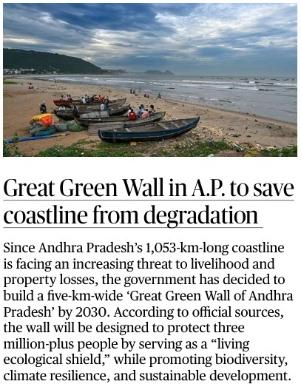
GS Paper: 3 – Environment, Climate Change, Disaster Management, Conservation Context: · The Government of Andhra Pradesh has announced plans to establish a five-kilometre-wide “Great Green Wall of Andhra Pradesh” along its 1,053-km-long coastline by 2030. · The initiative aims to combat coastal erosion, habitat degradation, and livelihood loss caused by rising sea levels, cyclones, and climate change. · The wall will serve as a “living ecological shield”, protecting more than three million people living in vulnerable coastal regions, while also promoting biodiversity, climate resilience, and sustainable development. Key Details & Design:
- Coverage: Entire stretch of Andhra Pradesh’s coastline from Srikakulam to Nellore, spanning 1,053 km.
- Width: Approximately 5 km inland from the shoreline.
- Components:
- Dense green belt with mangroves, casuarina, and native coastal vegetation.
- Sand dunes restoration and wetland conservation zones.
- Buffer plantations to reduce wind and wave energy.
- Integration with eco-tourism and livelihood opportunities (such as community forestry and fisheries).
UPSC Prelims Q. With reference to the “Great Green Wall of Andhra Pradesh,” consider the following statements:
1. It is a five-kilometre-wide green belt along the 1,053 km coastline of Andhra Pradesh.
2. The initiative aims to protect coastal populations by creating a living ecological shield.
3. The project is part of India’s National Coastal Mission under the National Action Plan on Climate Change (NAPCC). Which of the statements given above is/are correct?
(a) 1 and 2 only
(b) 1 and 3 only
(c) 2 and 3 only
(d) 1, 2 and 3
Answer: (d) 1, 2 and 3
Skilling for AI Readiness (SOAR) Programme Syllabus:
GS Paper II - Governance, Constitution, Polity, Social Justice and International relations
Topic: Government Policies and Interventions
Context:
India is embarking on a major initiative with the launch of the Skilling for AI Readiness (SOAR) programme by the Ministry of Skill Development and Entrepreneurship (MSDE). This programme aims to equip students and educators with foundational knowledge of artificial intelligence (AI), preparing them for the digital future.
Key Points:
- Launched by MSDE: The programme is a government initiative to integrate AI learning into the education and training ecosystem in India.
- Target Audience: It focuses on school students from classes 6 to 12, along with educators.
- Course Structure: Offers 15-hour modules for students and a 45-hour module for teachers, covering AI, machine learning, data literacy, and ethics.
- Funding: ₹500 crore earmarked in the Union Budget 2025-26 for establishing a Centre of Excellence in AI for Education.
- Centre of Excellence: The centre will focus on developing AI learning tools and promoting multilingual AI resources in Indian languages.
- AI Curriculum Enhancement: Aims to strengthen AI curriculum in technical institutions, complementing efforts by IITs and AICTE-approved colleges.
- Long-Term Vision: SOAR seeks to position India as a global leader in AI by preparing youth for AI-driven careers and entrepreneurship.
Source: DD News
Indian Scops-Owl Syllabus:GS Paper III - Environment, Ecology, Biodiversity, and Climate Change
Topic: Conservation, Environmental Impact, and Species Discovery
Context:
A rare sighting of the Indian scops owl near the Daroji Sloth Bear Sanctuary in Karnataka has captured the attention of birdwatchers. This discovery marks the first-ever recorded sighting of the species in this region, adding to the biodiversity knowledge of India.
Key Points:
- Scientific Name: Otus bakkamoena
- Native Range: Found in India, Nepal, Pakistan, Sri Lanka, and Iran.
- Habitat: Prefers forests, scrublands, and agricultural areas; non-migratory and remains in the same area year-round.
- Physical Features:
- Height: 17-20 cm
- Wingspan: 45 cm
- Stocky body, round head, short tail
- Large yellow eyes with black pupils
- Soft, fluffy feathers for insulation.
- Diet: A nocturnal hunter, feeding primarily on insects.
- Conservation Status: Classified as Least Concern by the IUCN Red List.
Source: NIE
Central Asian Mammals Initiative
Syllabus:
GS Paper III - Environment, Ecology, Biodiversity, and Climate Change
Topic: Conservation of Wildlife and International Environmental Agreements
Context:
Several Central Asian countries have recently endorsed the
Central Asian Mammals Initiative (CAMI) to strengthen cross-border cooperation for protecting 17 iconic migratory mammal species across the region.
Key Points:
- Launch Year: 2014 at COP11 to the Convention on the Conservation of Migratory Species of Wild Animals (CMS).
- Objective: To reverse the population decline of 17 migratory mammal species across 14 Central Asian nations.
- Framework: Provides a common conservation strategy to tackle major threats such as habitat loss, poaching, and fragmentation.
- Species Covered: Includes Argali sheep, Asiatic cheetah, snow leopard, saiga antelope, Persian leopard, Przewalski’s horse, wild yak, and Bukhara deer, among others.
- Programme of Work: The current plan (2021–2026) was adopted during CMS COP13.
About CMS (Bonn Convention): - An environmental treaty under the United Nations Environment Programme (UNEP).
- Signed in Bonn, Germany, on 23 June 1979.
- The only global UN-based intergovernmental framework for conserving migratory species and their habitats.
- Allows both legally binding agreements and non-binding instruments (like MoUs).
- The Conference of Parties (COP) is its main decision-making body.
Source: Down To Earth (DTE)
Trachoma
Syllabus:
GS Paper II - Health, Welfare and Social Sector Initiatives
Topic: Issues Relating to Health and Government Interventions
Context:
Fiji has become the
26th country to eliminate
trachoma as a public health problem, marking significant progress in global health efforts to combat preventable blindness.
Key Points:
- Cause: Bacterial infection caused by Chlamydia trachomatis.
- Mode of Transmission: Spreads through contact with infected eye, eyelid, nose, or throat secretions.
- Impact: If untreated, it leads to irreversible blindness.
- Vulnerable Groups: Common in communities living in poor sanitary and environmental conditions.
- Treatment: Managed using azithromycin or tetracycline ointment.
- Early Symptoms: Redness, swollen eyelids, blurred vision, watery eyes, and nasal discharge.
- WHO Initiative:
- Classified as a Neglected Tropical Disease (NTD).
- Affects nearly 150 million people globally.
- WHO promotes the SAFE strategy for elimination:
- Surgery for trichiasis
- Antibiotics to clear infection
- Facial cleanliness
- Environmental improvement
Source: World Health Organization (WHO)









